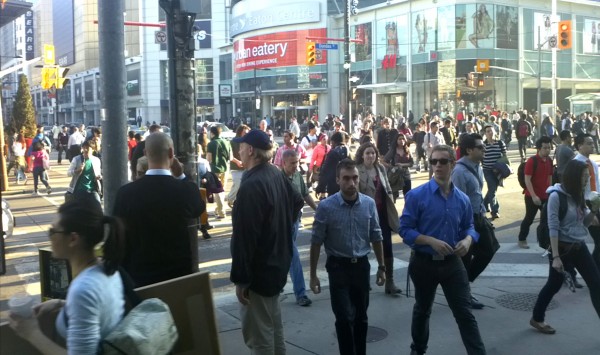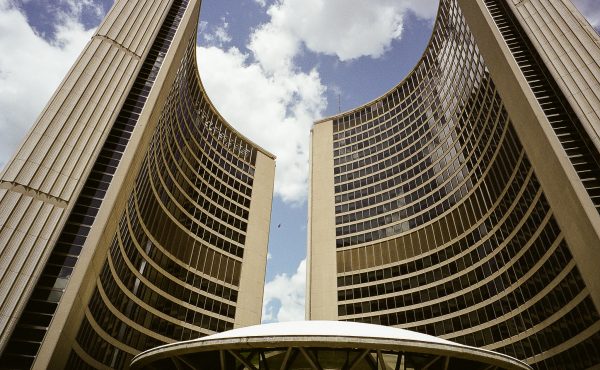I went to the talk by former New York City traffic commissioner Sam Schwartz on “Creating a More Walkable Toronto – Strategies from Chicago and New York City” on Tuesday. Schwartz is known as “Gridlock Sam” thanks to a column he writes for the New York Daily News (and a reputation for having popularized the term “gridlock”). His firm helped develop Chicago’s Pedestrian Plan and an America Walks guide called “Steps to a Walkable Community.” The talk was organized by the City of Toronto’s Public Realm Office, as part of a commitment in Toronto’s Walking Strategy to hold a public forum on walking once a year. It was organized in partnership with the Toronto Society of Architects.
Schwartz was introduced by Stephen Buckley, the new General Manager of Transportation for the City of Toronto, and it was an opportunity to see him in action for the first time too. Buckley led efforts to develop a “complete streets” policy in Philadelphia, where he previously worked. His influence perhaps helps to explain this week’s motion by Public Works and Infrastructure Committee chair Denzil Minnan-Wong to start Toronto on the process of developing Complete Streets Guidelines.
Buckley did a quick roundup of walking facts and policies at the City. He noted that Toronto has 7,100 km of sidewalks, 600 pedestrian crosswalks, and an estimated 1,000,000 signs. He also noted that Toronto has about $10 billion worth of transportation assets — and asked the audience to consider how much that meant we should invest in maintenance every year.
He announced that Transportation was launching a crosswalk-painting blitz downtown, where the markings have often faded terribly; and that they would be launching a transportation safety study.
Next up was Schwartz himself, who titled his talk “These streets are made for walking”. Here are a few notes on what he said:
- “Walkers are the oxygen of the city”
- Health has been increasingly added to transportation benefits as a reason to promote pedestrian infrastructure
- Walking is the most resilient form of transportation. After Hurricane Sandy hit New York City, it was the only way to get around the worst-affected parts of the city.
- “Streets say something about your city”. What people see of the street as they walk around will shape their impression of the city.
- The one thing that resonates when he is talking to older, driving-oriented people in the suburbs is that they will lose the young people in their community (the 20-35s) if their area doesn’t become less car-centric.
- A Street Design Manual (like New York’s) is key. Engineers will go to the manual — give them one that creates the city you want.
- It’s a myth that pedestrians vs. cars is always a zero-sum game. Many pedestrian and cycling improvements in New York also helped traffic flow better.
- There is no study that shows wider lanes are safer for drivers. 3 or 3.3 meters is fine. Which gives more room for sidewalks or bike lanes.
- Eliminating gaps and blockages in the pedestrian system is key. E.g. pedestrian bridges [I would add — improving sections of town that are hostile and unpleasant for walking — the gaps in the walking network].
- Washington State has adapted its driver education curriculum to address all modes of travel — so, how to watch for and consider pedestrians and cyclists.
One idea that I found interesting was “pedestrian traffic managers” — essentially crossing guards for adults. Usually retired police, they are hired to ensure safe pedestrian crossing for situations like heavily pedestrian events (e.g. after a pro sports game), dangerous locations, street festivals or construction zones. In New York, Schwartz’s firm provides these as a private for-hire service; that’s one model, but it could also be a branch of police services like crossing guards and traffic inspectors. It’s an idea that has the potential to improve pedestrian safety. It could also be a less expensive replacement for the off-duty police who are currently hired in some cases for this purpose.






2 comments
“Pedestrian Traffic Managers”… I have a very vivid memory of just one such example in Toronto from admittedly many years ago…. I was attending a very large conference here in Toronto (my home) and was departing the ACC after the morning “keynote” to travel to the “sessions” at the Convention Centre. Needless to say, the sidewalks were WAY over burdened with literally 1000s. We had to cross a street… York(?) There were lights there. It was amazing to see people were obeying the signals… but of course they were: there was a police officer standing at the corner. No doubt this officer was somehow provisioned on this day precisely to handle the problems that this many people pouring onto the street would create. Interestingly I observed the officer doing nothing at all but standing passively.
But two unfortunate facts conspired to create a nightmare situation:
1. This police officer did not like what he was doing and chose not to assist the walkers in anyway whatsoever
2. The traffic lights were composed of signals for cars PLUS button activated signals for walkers AND this was one of those very odd intersections where the signal can turn green for cars but remain “stop” for pedestrians when the button is not pressed
Unfortunately, the button was simply not used (probably because of the crush of the people… even those standing next to the button could not see it because the were too close to it.)
As a result, the pedestrian signals remained in the “stop” position even when the light was green for the cars. Oddly, the walkers weren’t smart enough to figure out the problem and chose to obey the “stop” signal en masse… probably unintentionally cued by the presence of the police… I think at least two signal cycles completed before I found the button and relieved the situation.
Frankly, I didn’t understand what was happening — and apparently nor did anybody else — until some reflection after the fact. That officer knew exactly what was going and chose not to help (I had spoken to him — helpfully — but he shrugged off my comments).
The point: pedestrian traffic managers are a fine idea provided they are trained to be truly effective.
Saw a squad car rolling through a pedestrian walk-way in a large park.
I noticed the car was stalking a group of black men who didn’t seem to be doing anything of suspect. Before I knew what I was saying I yelled out two words “racial profiling”.
That cop decided to pull me over on my bike, intimidate me and waste my time (Was working a courier at the time.)
I called his bluff, pulled out a cycling magazine and read a good article til’ the he decided it was tim-bit tuesday or whatever.
Long story short, cops are a huge waste of money. They are the #1 budget hog (no pun intended), if we were to take 1% of that and put it towards transit Toronto would truly become a world-class city.